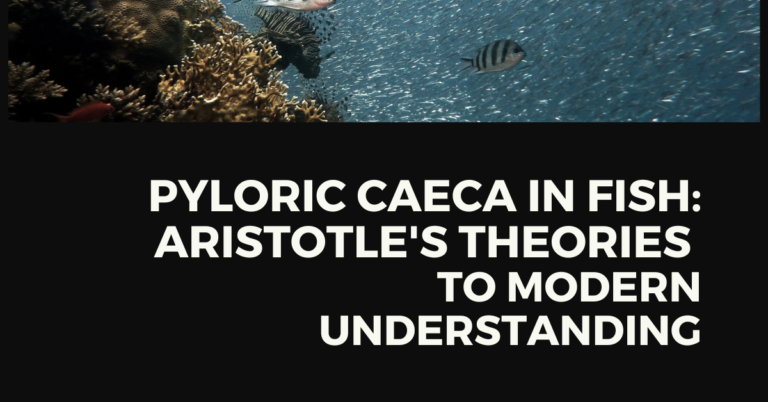The pyloric caeca, first described in detail by Aristotle in 345 B.C., has long been a subject of curiosity and debate regarding its function in fish physiology. Aristotle proposed three hypotheses regarding the function of these structures: “to store up the food,” “putrify it up,” and “concoct it,” referring to storage, fermentation, and digestion, respectively. Centuries later, modern scientific exploration has shed new light on the role of pyloric caeca in fish, particularly focusing on species like trout, cod, largemouth bass, and striped bass. This article delves into the historical context of Aristotle’s theories, the evolution of understanding about pyloric caeca, and the contemporary perspective on their function in fish biology.
Aristotle’s Theories on Pyloric Caeca
Aristotle’s observations and hypotheses laid the foundation for early understanding of anatomical structures and physiological processes in living organisms. In his writings, he speculated about the potential functions of pyloric caeca based on their anatomical location and association with the digestive system. The three theories proposed by Aristotle – storage, fermentation, and digestion – reflected his attempts to rationalize the purpose of these structures within the context of ancient knowledge and limited scientific methods.
- Storage Hypothesis: Aristotle’s suggestion that pyloric caeca’s serve as storage sites for food echoes the concept of reservoir organs in the digestive tract. This theory implies that fish may use these structures to temporarily store ingested food before further processing and absorption.
- Fermentation Hypothesis: The notion of putrefaction or fermentation in pyloric caeca aligns with early ideas about microbial activity in digestive processes. Aristotle’s hypothesis suggests a role for microbial fermentation within these structures, akin to the fermentation chambers found in some mammalian digestive systems.
- Digestion Hypothesis: Aristotle’s “concoction” theory proposes that pyloric caeca’s are involved in the chemical breakdown and digestion of food components. This theory implies an active role for these structures in enzymatic digestion, similar to the functions of other digestive organs.
Modern Insights into Pyloric Caeca Function
Advancements in anatomical studies, physiological experiments, and molecular techniques have provided a more nuanced understanding of pyloric caeca function in fish. Research focusing on trout, cod, largemouth bass, and striped bass has revealed intriguing insights that challenge and refine Aristotle’s ancient hypotheses.
- Site of Nutrient Absorption: Contemporary studies have demonstrated that pyloric caeca in fish serve as major sites of nutrient absorption, particularly for sugars, amino acids, and dipeptides. Contrary to the storage hypothesis, these structures actively participate in nutrient uptake from ingested food.
- Enzymatic Activity: Analysis of caecal brush-border membranes has revealed the presence of hydrolytic enzymes, supporting the digestion hypothesis. These enzymes play a crucial role in breaking down complex food molecules into absorbable nutrients within the pyloric’s caeca.
- Dynamic Function: Observations using radioopaque markers and dye studies have highlighted the dynamic nature of pyloric caeca’s function. These structures exhibit filling and emptying patterns that coincide with the digestive processes occurring in the proximal intestine, emphasizing their active role in food processing.
- Surface Area Expansion: Unlike the fermentation chambers seen in mammals and birds, fish pyloric caeca are adaptations designed to increase gut surface area. This adaptation enhances nutrient absorption efficiency, contributing significantly to overall digestive capabilities in aquatic species.
Implications for Fish Physiology and Evolution
The elucidation of pyloric caeca’s function has broader implications for understanding fish physiology, evolutionary adaptations, and ecological interactions. Key insights include:
- Efficient Nutrient Utilization: The specialized functions of pyloric caeca contribute to the efficient utilization of nutrients in fish diets, particularly in species that rely on diverse food sources in aquatic environments.
- Evolutionary Adaptations: The presence and functional diversity of pyloric caeca across various fish species underscore evolutionary adaptations shaped by ecological niches and dietary preferences.
- Dietary Strategies: The role of pyloric’s caeca in nutrient absorption highlights the importance of considering digestive physiology in designing optimal diets for aquaculture and conservation efforts.
- Comparative Anatomy: Comparative studies of digestive systems, including pyloric caeca’s, offer valuable insights into evolutionary relationships and physiological diversity among vertebrates.
Future Directions in Pyloric Caeca Research
Continued research on pyloric caeca is poised to uncover further intricacies of fish digestive physiology and adaptation. Future directions may include:
- Molecular Mechanisms: Exploring the molecular mechanisms underlying nutrient transport and enzymatic activities within pyloric caeca’s.
- Ecological Context: Investigating the impact of environmental factors, diet variability, and ecological interactions on pyloric’s caeca function.
- Evolutionary Significance: Examining the evolutionary history and genetic basis of pyloric caeca diversity among fish taxa.
- Applied Implications: Translating insights from pyloric caeca research into practical applications for aquaculture, fisheries management, and conservation biology.
Conclusion
In conclusion, the journey from Aristotle’s ancient theories to modern scientific understanding highlights the complexity and significance of pyloric’s caeca in fish biology. These structures, once shrouded in mystery, now stand as emblematic examples of physiological adaptation and functional specialization in aquatic organisms. Ongoing research endeavors promise to unveil deeper insights into the intricate workings of pyloric caeca and their broader implications for vertebrate digestive systems.

